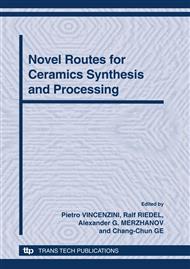p.14
p.24
p.30
p.36
p.41
p.47
p.52
p.58
p.62
Tailored Silica Based Xerogels and Aerogels for Insulation in Space Environments
Abstract:
In this work, the sol-gel technology is used to produce silica based xerogels and aerogels suitable for insulation applications in Space. The properties of the obtained materials are tailored varying the precursor – Methyltrimethoxysilane (MTMS) or Methyltriethoxysilane (MTES), and the solvent – methanol or ethanol. A two-step acid-base catalyzed synthesis is used, being the obtained gels dried at atmospheric pressure, in the case of xerogels, and in supercritical conditions, for aerogels. Density and thermal conductivity must be made as low as possible for the sought application and only highly porous materials can fulfill this requirement. The obtained xerogels and aerogels, either with MTMS or MTES, show very promising properties for thermal insulation in Space, when methanol is used as solvent. The more suitable materials are obtained with MTMS and exhibit very low density (80-100 kg/m3), very high surface area (~ 400 m2/g) and small pore size (~ 30-40 Å). They also show moderate flexibility and a remarkable hydrophobic character (~ 150º).
Info:
Periodical:
Pages:
41-46
Citation:
Online since:
October 2010
Price:
Сopyright:
© 2010 Trans Tech Publications Ltd. All Rights Reserved
Share:
Citation:


